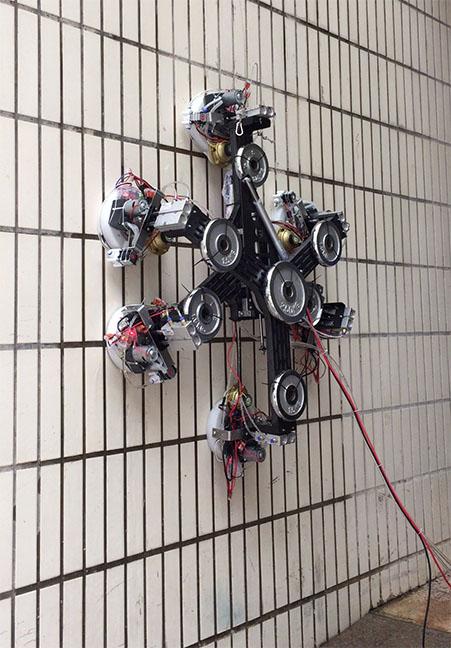Spider-Man-style robotic graspers defy gravity

A wall-climbing robot uses the zero-pressure difference method to form suction. Credit: Xin Li and Kaige Shi
Specially designed vacuum suction units allow humans to climb walls. Scientists have developed a suction unit that can be used on rough surfaces, no matter how textured, and that has applications in the development of climbing robots and robotic arms with grasping capabilities.
Traditional methods of vacuum suction and previous vacuum suction devices cannot maintain suction on rough surfaces due to vacuum leakage, which leads to suction failure.
Researchers Xin Li and Kaige Shi developed a zero-pressure difference (ZPD) method to enhance the development of vacuum suction units. Their method overcame leakage limitations by using a high-speed rotating water ring between the surface and suction cup to maintain the vacuum. They discuss their work in this week's Physics of Fluids, from AIP Publishing.
“There are many applications of our design, but we think the wall-climbing robot will be the most useful,” said Li. “Compared to other wall-climbing robots, the robot with our ZPD-based suction unit achieves surprising improvement in performance.”
The centrifugal force of the rotating water eliminates the pressure difference at the boundary of the vacuum zone to prevent vacuum leakage. It can maintain a high vacuum pressure inside the suction cup.
Their ZPD suction unit is energy-efficient and smaller and lighter than traditional suction units. The researchers tested their unit with three different suction sizes and applications: on a robotic arm to grip and handle objects, on a hexapod wall-climbing robot and as a Spider-Man-like wall-climbing device.
“The next step in this research is to cut down the water consumption. If the water consumption can be reduced, the suction unit will work for a very long time with little water so that the wall-climbing robot could carry its own water instead of being connected to a supply,” said Li.
###
The article, “Vacuum suction unit based on the zero pressure difference method,” is authored by Kaige Shi and Xin Li. The article appears in Physics of Fluids (DOI: 10.1063/1.5129958) and can be accessed at https:/
ABOUT THE JOURNAL
Physics of Fluids is devoted to the publication of original theoretical, computational, and experimental contributions to the dynamics of gases, liquids, and complex or multiphase fluids. See https:/
Media Contact
More Information:
http://dx.doi.org/10.1063/1.5129958All latest news from the category: Physics and Astronomy
This area deals with the fundamental laws and building blocks of nature and how they interact, the properties and the behavior of matter, and research into space and time and their structures.
innovations-report provides in-depth reports and articles on subjects such as astrophysics, laser technologies, nuclear, quantum, particle and solid-state physics, nanotechnologies, planetary research and findings (Mars, Venus) and developments related to the Hubble Telescope.
Newest articles

Recovering phosphorus from sewage sludge ash
Chemical and heat treatment of sewage sludge can recover phosphorus in a process that could help address the problem of diminishing supplies of phosphorus ores. Valuable supplies of phosphorus could…

Efficient, sustainable and cost-effective hybrid energy storage system for modern power grids
EU project HyFlow: Over three years of research, the consortium of the EU project HyFlow has successfully developed a highly efficient, sustainable, and cost-effective hybrid energy storage system (HESS) that…

After 25 years, researchers uncover genetic cause of rare neurological disease
Some families call it a trial of faith. Others just call it a curse. The progressive neurological disease known as spinocerebellar ataxia 4 (SCA4) is a rare condition, but its…





















